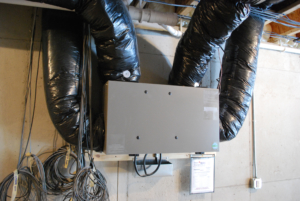As any green builder would say, “Build tight – Ventilate right”. This is not just your typical way to build, but a more sustainable and efficient way to construct a house. One component that speaks to the “ventilate right” portion of the equation is an Energy Recovery Ventilator (ERV). An ERV makes it possible to control the fresh air that is moving in and out of your house. We call it the “lungs of the home”.
In typical construction, most new air gets into the house through gaps and cracks in the building envelope. However, this air is completely uncontrolled and could be leaking into the house from the basement, attic, crawl space, or attached garage. This could easily be contaminated, unhealthy air.
The alternative? Build tight – ventilate right. The first step is to air seal the home and stop uncontrolled air from entering. Many overlook the simple steps it would take to make the home more efficient. When a home is air sealed properly, blower door tests that are 40-80% above “Energy Star” standards can be achieved. It is then imperative to install an ERV to control fresh air into the home. This air exchanger will recover up to 80% of the indoor heating and cooling, therefore controlling indoor air temperature without losing energy. Simply depending on an exhaust fan, which can only remove air, is not enough.
ERV’s are also one of the healthiest ways to bring fresh air into a home. Some ERV’s can even have special filters that will filter pollen, mold spores, bacteria, and smog before entering the home. These pollutants can cause fatigue, headaches, dizziness, and difficulty concentrating. Having clean air in a home, on the other hand, is associated with restful sleep, better concentration, and a stronger immune system.
Climate also is a contributing factor when considering the installation of an ERV. ERV’s tend to be more common in homes that are located in climates with dry winters and/or humid summers. In the winter months, the ERV makes it possible to keep humidity in an ideal range by capturing the moisture from exhaust air and transferring it to intake air. In the summer when people want less moisture and humidity, the air is taken from the intake and transferred to the exhaust, lowering moisture levels.
There are many components that go into having a sustainable, healthy home. It all begins with a structure that is well built and tight, then continues with fresh air from the “lungs of the home”, the Energy Recovery Ventilator.



